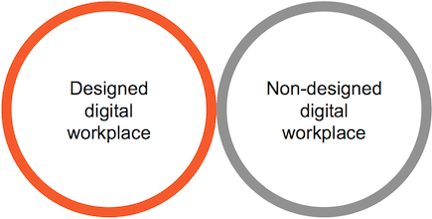How user experience debt bankrupts your digital workplace

Synopsis: Saving money by not providing a good user experience in your digital workplace costs you money and goodwill elsewhere. A good digital workplace could be one of the tenets of employee engagement.
While the intranet and other digital workplace tools aren’t “all about the technology”, they are technical projects at the start. Budget is found, decisions are made, designs drawn, configurations fettled and the code is cut.
But if you are in this trade, you will recognize this scenario: The project manager’s unholy trinity of “Time, cost, quality… pick any two” eventually breaks like a wave over the good intentions of the project team. She looks you in the eye and utters the inevitable: “We don’t have the time or money for that feature.”
Deep down, you know she’s right. But dammit, it’s going to suck for people without that feature. You make some feeble excuses about it being all about the user experience, but the manager’s steely gaze locks onto you: “We’ll add the workaround to the training. If it’s a problem we can fix it later.”
Origins of the “user experience debt” concept
Now let me introduce you to a useful concept – that of user experience debt. Put simply, a digital workplace that lacks polish and has a poor user experience will spread its inefficiencies around your organization.
The term itself is a descendant of the term “technical debt” coined by Ward Cunningham (a clever chap, he also invented the wiki). Technical debt means that any part of a programming project you don’t do before the shipping date, still has to be done at the beginning of the next phase. So, if you’ve lashed up some rubbish code to hit a deadline, at some point this will need to be translated from spaghetti into something maintainable. If you’ve not created the right documentation, someone will need to do that before you can proceed.
When usability improvements fall prey to project timelines
User experience debt is similar. Say the project team (and I’m not just picking on project managers here) has had to take the hard decision not to fix a nasty usability problem that has been identified during testing, because the launch date was already fixed, this usability snafu will go out into the world to trip up the majority of users that come across it. The team then has to spend time backtracking and getting their heads around this issue that should have been fixed in advance. As well as time, a little bit of goodwill is burnt up as their days have just been made that little bit harder. You might even consolidate a negative image already in their heads about the rubbish company they work for and chip away a little at their personal engagement with their work. Go team. Not really.
Let’s say the usability hit would have taken a day to fix, and you could have launched a day later, you would have got that time and money back in the hassle saved. I am presuming here, of course, that since you did some user testing of your new digital workplace tool, then you also have some agile method of development. Great! All is not lost. You know what the major problem is and you fix it as soon as possible. Nice work. No, really!
So now let’s take a step down into the next circle of hell. You don’t care. Or maybe you do – you’re a good egg. But that project manager… what a piece of work she is! She only cares about time and budget, and there is just no time or budget to fix that snafu. It is locked in as a source of inefficiency for ever, like a corporate ulcer. This is just plain nasty and a false economy… but it happens all the time.
What part of your digital workplace do you control?
If you recall from my earlier post though, there are two sorts of digital workplace tool. The first is the classic development we have used as an example in this post: where you develop or configure something yourselves and have control over the user experience – say, for example, you are creating an expenses application from scratch and have the developer sitting right there, with the information architect and the graphic designer; they can all work together to stamp on that snafu your usability guy has spotted in the testing. You lucky ducks.

The other side is the world of the non-designed digital workplace. This is the arena of the “off-the-shelf” product and the cloud provider. Outlook, the rest of Microsoft Office and your VPN solution all live here, as do Yammer, Salesforce and a host of others. Maybe in our example above you’re working with an expenses application you’ve bought from a third party.
Inherited UX debt from third party applications
The user experience debt locked into these tools is there courtesy of the vendors that provide them, but you no doubt won’t have calculated the cost of the drag this can cause into the total cost of ownership. A product that is cheap but has terrible user experience might be costing way more than it says on the cost centre budget. And the real kicker? You have no way of fixing it.
You might try certain limited remedies – sticking plasters – chucked hopefully like a lifesaver from the designed digital workplace (training, communications, direct links to stuff), but in general you are now at the mercy of the vendor. Vendors these days are usually very much the champions of user experience, so this is less of a problem than it used to be, but buyer beware. Get in there at the procurement stage and try to spot the turkeys.
Start with “hygiene” applications to build UX capital
The final point to make is the difference between the tools you have and the processes they support. Try and figure out which ones really provide a business advantage (holographic video conferencing? rocket packs?) and which ones are hygiene factors (the expenses system et al.). I have a sense that spending all the time and money on new cool stuff while failing to focus on the basics is in danger of chasing rainbows, particularly where efficiency and engagement are concerned. It is pretty clear that failing to provide a hygiene factor is disproportionately worse than managing to provide a business advantage: “I’ve just been given a holographic video conferencing system but I can hardly submit my blinkin’ expenses…”
It is time to think about the digital workplace as a major factor in employee engagement. This is a simple mantra: Find out what’s broken and hurting people, and fix it. And remember:
“I hate to be a kicker,
I always long for peace,
But the wheel that does the squeaking,
Is the one that gets the grease.”
Related research
Digital workplace user experience – designing for a flexible workforce
 The digital ecosystem of applications and systems provided to employees have usually been built-up piecemeal for a desk-bound user population.
The digital ecosystem of applications and systems provided to employees have usually been built-up piecemeal for a desk-bound user population.
The report suggests that organizations can tackle issues such as loss of productivity and reduced adoption of critical services by looking at the digital workplace through the lens of the user experience.
Categorised in: Digital workplace, Digital workplace strategy
